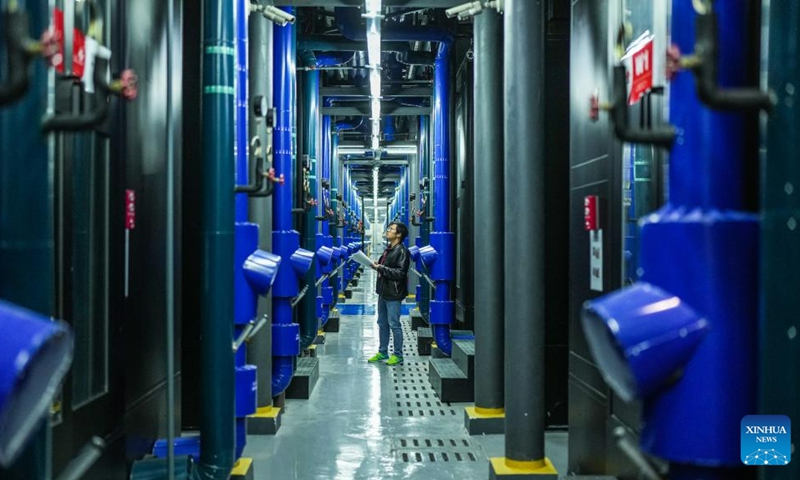Xiconomics in Practice: Xi’s leadership steers Chinese economy toward high-quality development in 2023

In mid-December 2022, after China started to ease COVID-19 restrictions that had lasted for three years, the world keenly anticipated a swift and robust recovery in China's economy in 2023. But at a tone-setting economic conference, top Chinese policymakers, while stressing that "an overall recovery and improvement is expected," also offered a sobering assessment of the difficulties that lay ahead.
"Economic work in 2023 will be complex," Xi Jinping, general secretary of the Communist Party of China (CPC) Central Committee, Chinese president and chairman of the Central Military Commission, concluded in a speech at the Central Economic Work Conference (CEWC) on December 15, 2022. The meeting, aimed at setting priorities for economic work in 2023, demanded making economic stability a top priority and pursuing steady progress while ensuring economic stability.
As 2023 draws to an end, what transpired in the Chinese economy over the last year is consistent with that assessment. The economy faced serious downward pressure from shrinking demand, supply shocks, and weakening expectations - "triple pressures" as officials put it. But it also mounted an impressive recovery, with the GDP growth rate widely expected to meet or even exceed an initial target of around 5 percent, a remarkable improvement from the previous three years during the pandemic. More crucially, China also achieved solid progress in high-quality development, with the rise of domestic consumption, scientific and technological innovation, and green development.
All told, China's recovery has become one of the biggest highlights for the global economy in 2023 amid a severe downturn and a complex geo-economic situation - China is expected to be the fastest-growing major economy and contribute roughly one-third of global growth, according to Chinese and foreign economists. Beyond the direct contribution to growth, faster growth in China also has positive spillover effects on the rest of the world: A single percentage point of growth in China, on average, increases output in other economies by 0.3 percent over the medium term, according to the IMF.
Behind such a hard-won, impressive outcome are objective and scientific decision-making by Chinese policymakers under Xi's leadership, a series of targeted and effective policies to tackle risks and challenges head-on, as well as the effective execution of those policies - the quintessential Chinese governance model that underpins China's long-running economic miracle, economists said.
This also vividly demonstrated how Xi Jinping's economic thought, which, among other things, stresses high-quality development, is put into practice to address problems and promote high-quality development, they noted.
Hard-won, impressive outcome
China's economic recovery was by no means smooth in 2023.
"In fact, the post-pandemic economic recovery was full of difficulties and challenges. Some were unprecedented. Despite all these [challenges], China took a series of measures and deepened reforms and opening-up. We achieved an effective improvement in quality and reasonable growth in quantity," Guan Tao, global chief economist at BOC International under the Bank of China, told the Global Times. "This indeed is a very hard-won outcome."
China's economy grew by 5.2 percent year-on-year in the first three quarters, and the full-year GDP growth rate is expected to exceed the official growth target of around 5 percent. That is a remarkable comeback from a 3 percent rate in 2022 and significantly higher than the average growth rate of 4.5 percent between 2020 and 2022. Globally, a 5-percent growth rate in China would also largely outpace a projected global growth rate of 3 percent, 1.5 percent in advanced economies, and 4 percent in emerging markets and developing economies, according to the IMF.
What's more, international organizations have constantly upgraded China's growth forecasts, in stark contrast to grim predictions hyped by some Western economic pundits and media outlets.
"We recently upgraded our 2023 forecast to 5.4 percent. This forecast was increased by 0.4 percentage points in November," Steven Alan Barnett, senior IMF resident representative in China, told the Global Times in an exclusive interview. "At 5.4 percent growth, China by itself would explain around one-third of global growth in 2023."
Apart from growth in quantity, China's high-quality development also made significant strides in 2023, reflected in the rapid rise of new emerging industries, breakthroughs in critical technologies, the transition toward consumption-led growth, and the expansion of green development.
High-quality development
Barnett highlighted China's rapid growth in new industries like electric vehicles (EVs) and green technologies that offered a cushion against other downward pressures. "China, in fact, stands out as a technological leader in the production of green technologies such as solar panels and EVs," he said.
In a remarkable example, China surpassed Japan to become the world's biggest auto exporter in the first quarter of 2023, thanks to the new-energy vehicles (NEVs) sector. In the first 11 months, NEVs output grew by 34.5 percent to 8.426 million units, while sales increased by 36.7 percent to 8.304 million units, according to the latest industry data. More than 64 percent of global NEVs sales were in China during the period, according to the 2023 World New Energy Vehicle Congress.
Also highlighting progress in China's innovation-driven high-quality development, in November, the added value of high-tech manufacturing above designated size increased by 6.2 percent year-on-year, 4.4 percentage points faster than that of the previous month. High-tech products such as solar cells, service robots, and integrated circuits continued their stellar performance, with their output rising 44.5 percent, 33.3 percent, and 27.9 percent, respectively.
That helped promote high-quality development in China's foreign trade, with the upgrade of the export structure. In the first 11 months, China's exports of NEVs, lithium batteries, and solar cells - collectively known as "the three new items" of China's exports - jumped by 41.7 percent to about 79.9 billion yuan.
Also underscoring China's optimizing trade structure, "during a period of declining orders from the US and Europe, China's trade with emerging markets continues to grow," Wei Jianguo, former Chinese vice minister of commerce and executive deputy director of the China Center for International Economic Exchanges, told the Global Times.
Another highlight of China's high-quality development is the rise of domestic consumption as the main economic growth driver. In the first 11 months, total retail sales, a main gauge of consumption, grew by 7.2 percent year-on-year to about 42.8 trillion yuan, with a 10.1 percent growth in November. "Consumption explained around 80 percent of growth in the first three quarters of the year," Barnett said.
Innovation-led and consumption-driven growth is a crucial part of China's high-quality development, which is at the front and center of China's economic policymaking. This year's CEWC, held on December 11 and 12, stressed that it is imperative to uphold high-quality development as the unyielding principle of the new era. The phrase has drawn much attention as it resembles the popular Chinese saying "development is the absolute principle," popularized during the decades of reform and opening-up that ushered in China's rapid economic rise.
Decisive top-down leadership
How did China overcome difficulties and challenges and achieve these hard-won gains? Decisive top-down leadership is the key, economists said.
Over the last year, at major meetings and inspection tours across the country, Xi has repeatedly called for efforts to tackle challenges, stabilize growth, and promote high-quality development.
In his speech at the CEWC last year, Xi stressed "We need to bear in mind the overall strategic picture and focus on major problems" and offered clear guidance on how to tackle them. He called for efforts to expand domestic demand, build a modern industrial system, develop the public sector and support the non-public sector, attract and utilize foreign investment, and forestall and defuse risks in areas such as real estate, financial market and local government debt.
This guidance has since turned into policy actions over the last year. Overall, China has adopted proactive fiscal and prudent monetary policies that have supported economic recovery. In the budget adopted in March, consumption, technological innovation, and high-quality development were prioritized.
Throughout the year, Chinese officials both at the central and local levels released an array of policy measures to support consumption, investment, and the private sector.
China also welcomed a long stream of global business executives and hosted many high-level trade fairs to boost cooperation.
Then in July, amid new challenges and weakening expectations, Xi presided over a meeting of the Political Bureau of the CPC, to set priorities for economic work in the second half of the year. While noting "new difficulties and challenges," the meeting called for solid efforts to expand domestic demand, shore up confidence, and prevent risks. That also led to strong policy measures in the second half of the year, including a plan to issue an additional 1 trillion yuan in treasury bonds in the fourth quarter.
The meeting also stressed that China's economic recovery was a "wave-like" and "zigzag" process. That demonstrated top officials' confidence in the economy, as they are trying to convey a message that China's economy may face high waves but it will always break through and it may zigzag but it will always move forward.
This is very typical of Chinese policymaking - confident in China's development, responsive to new situations, and swift and effective in responding to them, economists said.
"[Top officials] grasp issues in a very objective manner and take measures in a very swift and targeted manner," Guan said.
This has not only helped underpin China's stable economic recovery in 2023 but has also boosted confidence in China's 2024 economic recovery, despite lingering risks and challenges.
"Amid high winds and strong waves in the global economy, China's economy is making solid progress toward the future, forming synergy through optimization and balance, continuously releasing strong development momentum, and demonstrates bright prospects," Cheng Shi, chief economist of ICBC International, told the Global Times.
This year's CEWC, which sets the economic agenda for 2024, noted that some difficulties and challenges must be tackled to achieve further economic recovery and pledged a series of policy measures in a wide range of areas.
"The favorable conditions for China's development outweigh the unfavorable ones, and the overall trend of economic recovery and long-term improvement remains unchanged," it said.







